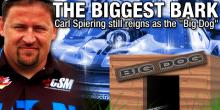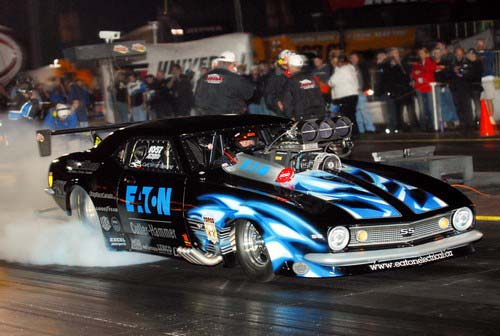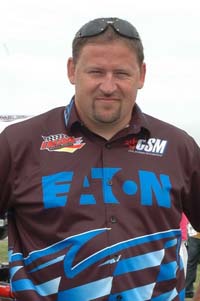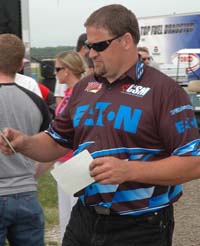CARL SPIERING - Drag Racing's Big Dog
 This an instance where the
bite is as bad as the bark...
This an instance where the
bite is as bad as the bark...
Canadians have always had a presence in Pro Mod--Al Billes, for one--but lately there’s been a profound surge in performance coming out of the Great White North. Whether it’s Billes’ influence as a consultant, more IHRA events being held north of the border, or even global warming, we’ve all read how Glen Kerunsky, Raymond Commisso, and Tony Pontieri have made big gains. Those drivers used to fly just under the radar, and so did Carl “Big Dog” Spiering.
This canine’s bite eventually measured up to his bark, however.
Spiering used to be a part-timer – running events close to his home base in Ontario, Canada, that were beneficial to his sponsors. Then he attained success and with that he chose to broaden his horizons. The 2006 IHRA tour marked his first full 11-event season.

Canadians have always had a presence in Pro Mod--Al Billes, for one--but lately there’s been a profound surge in performance coming out of the Great White North. Whether it’s Billes’ influence as a consultant, more IHRA events being held north of the border, or even global warming, we’ve all read how Glen Kerunsky, Raymond Commisso, and Tony Pontieri have made big gains. Those drivers used to fly just under the radar, and so did Carl “Big Dog” Spiering.
 This canine’s bite
eventually measured up to his bark, however.
This canine’s bite
eventually measured up to his bark, however.
Spiering used to be a part-timer – running events close to his home base in Ontario, Canada, that were beneficial to his sponsors. Then he attained success and with that he chose to broaden his horizons. The 2006 IHRA tour marked his first full 11-event season.
What was the catalyst that propelled him from part-time to full-time? Spiering got a taste of the big time by not only gaining a berth in the 2005 Torco Race Fuels Pro Modified Shootout but also winning the $20,000 grand prize. He also went on to record four final round appearances, winning once.
Spiering soon realized that full-time race produced unreal demands, however. As good as his 2005 season was, 2006 proved to be just the opposite. Spiering didn’t even get past the first round of eliminations at 6 of 11 IHRA national events. There were some bright moments, however. Despite a season opening crash in San Antonio, Spiering’s blown Eaton Electrical '67 Camaro never once missed making the field. He made qualified in the top 10 on 10 occasions, and made it into the top five seven times. His best qualifying spot on the season was No. 3, which he earned three times, the last came on the strength of a 6.036 second, 235.97 mph effort at the IHRA World Finals at Rockingham, North Carolina.
Thanks to a seventh-place finish in IHRA eMax Nitro Jam™ Drag Racing Series points last season, Spiering now leads qualifying for the 2007 Torco CompetitionPlus.com Pro Modified Shootout, a special program to be held at the IHRA Northern Nationals in Martin, Michigan.
a d v e r t i s e m e n t
Click to visit our sponsor's website
 Do not be
deceived, Spiering is a force to be reckoned with.
Do not be
deceived, Spiering is a force to be reckoned with.
His secret weapon? An extraordinary engine program--his own. Engine Research & Development, or E.R.D., is a 6000 square foot shop in Jordan Station, Ontario. “I maintained my engine program from day one,” said the 42-year-old racer. “I’d have outside people do the machining and I’d do the engine assembly. (But) I had run into a wall; our competition level was far below their capabilities. It became obvious that for me to compete and win, I’d have to go my own way. So two years ago we opened up our business.”
“I hired two fellows,” Spiering said, “Terry Vince and Rob Becker, who came from a small cubic inch, naturally aspirated engine business. Everybody needs someone to bounce ideas off of and that’s where I’m at with Terry Vince. I have my theories on supercharged methanol, he has his theories on normally aspirated motors. Efficiency is his goal and brute power is mine—but you can make it easier with efficiency. We’ve combined their efficiency with our supercharger technology to build a really strong, competitive engine that lasts and doesn’t give us trouble. Up until this year I haven’t been selling this as a service, but we’re currently going to show up in quite a few cars this year. We also do a lot of work in asphalt and dirt oval racing, and were able to win the local championship in Dirt Modified last year.”
This previously low profile Pro Modified racer actually started his pro racing career with snowmobiles. “Our winters were so long, I just though it would be neat to build a drag sled,” Spiering said. He soon had a factory-backed Ski-Doo team with five snowmobiles. For four years he toured around Ontario and New York, topping his sled racing with a class win at the New York State Grass Drags. However, with a growing family, ’Big Dog’ returned to drag racing so that his wife and daughter could at least join him at the track during the summer.
After a year interning with Todd Paton’s crew and running nitrous on his own ‘37 Chevy, Spiering entered the ranks of Pro Mod in 1999 as a driver for the Persico brothers. During his tenure there the team switched to supercharging and he got to race at the 2000 NHRA U.S. Nationals. By the end of the season, however, Spiering had decided to field his own Pro Mod. By 2001 he had a 1957 Chevrolet Bel Air and had secured sponsorship from Eaton Electrical. But with only one IHRA national event win under his belt, Spiering didn’t really ‘burst’ upon the Pro Mod scene until 2005, when he ran as an alternate for an ailing Al Billes at the Torco Race Fuels Pro Modified Shootout in Martin, Michigan. With his new engine program in place, his ’63 Corvette qualified No.1 and won the event.
a d v e r t i s e m e n t
Click to visit our sponsor's website
 In 2005
Spiering began seriously pursuing the IHRA national event tour, placing third
in points despite running a limited schedule. His success led to a reputation
that stretched overseas. Last August Spiering spent a weekend in England as a
consultant for Gordon Appleton’s Pro Mod team.
In 2005
Spiering began seriously pursuing the IHRA national event tour, placing third
in points despite running a limited schedule. His success led to a reputation
that stretched overseas. Last August Spiering spent a weekend in England as a
consultant for Gordon Appleton’s Pro Mod team.
Spiering had every intention of pursuing the title in 2006 and felt the odds were stacked in his favor based on his success the previous season. He was even preparing a new 1967 Camaro to better battle the ever-improving competition. That was a good thing for him because Spiering crashed his 1963 Corvette at the season-opener. The new car was originally scheduled to be a research and development vehicle, but those plans were squashed with the mishap.
The construction plans were accelerated, and twenty days later he qualified in Rockingham with the brand new Camaro. “I probably should have bowed out of that race, because I don’t think I was physically 100 percent ready,” he said.
“As far as the points go, finishing seventh is not where I wanted to be,” Spiering said. “While the transition from my tried and true ’63 Corvette to the new G-Force ’67 Camaro was good—I have not one complaint about the car—it did have a different clutch pedal mechanism, and a different driver’s seat position. But no excuses, if anything failed, it was the driver. I lost five rounds of racing on reaction time. That just goes back to me being comfortable in the car; maybe the accident did set me back a little bit. I don’t know.”
Another learning curve was the newfound power his engine program was producing. “As the power increases, the gear ratios, the clutch management and fuel management is all changing,” Spiering said. “There’s ballast in the car that needs to be moved around, there’s wing angles to be dealt with. Over the course of the season we’ve been changing, changing, changing. Although we qualified with deadly consistency, come race day we didn’t always make the right choice for the race track conditions.”
a d v e r t i s e m e n t
Click to visit our sponsor's website
Despite last season’s remarkable advances, Spiering has chosen to only run selected national events this season. “Eaton Corporation’s Canadian operations are the people who back my program. They are mainly concerned about my doing very well in the Canadian market. We’ve chosen only to run two of the U.S. events; Milan and Martin, Michigan. For all of the other races I will be on the grounds working for a few other teams, for as the season begins there will be a fair number of cars running our power. Going into the 2008 season we also have two very high profile teams coming out. It’s going to be a big deal.
“I don’t want to sound like I’m backing off,” said Spiering, “but I’ve got a 16-year-old daughter who’s going to be licensed for Super Comp. She’s got a brand new dragster—I just finished dyno testing her motor. I really want to focus on growing my engine building business, but I also want to be there for her, because this is a big step from Jr. Dragster. Once I get her up and rolling I want to get right back at the Pro Mod class, because I’m going to be in it a long time--I’m not going away. Both Terry and I are young, we have a very good business and we are spending a tremendous amount of time and money in R&D, and we have some really exciting things coming out.”
So why does Spiering think he and his countrymen are coming to dominate Pro Mod? “A lot of the credit goes to Al Billes; he really dabbled in it first. But I don’t know if the U.S. guys know how hard it is for us, the amount of traveling, the aggravation at the border and the amount of money—one year ago today we were paying 60 cents on every U.S. dollar. We’re racing with a larger need to succeed. And each and every one of us is independent. In the U.S. contingent there are multiple owners, and many wealthy car owners with drivers. When we go to Rockingham, we drive for 15-16 hours. For most Americans, going to Rockingham isn’t that big a deal; we have a bigger goal.”
That is, by God they’re going to go back home with something.
| {loadposition feedback} |





